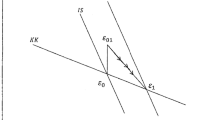Abstract
In this paper attention is focused on the economic and political effects of an aging population. For that purpose, a general equilibrium model is used that allows for an endogenous analysis of decisionmaking on government policies. We concentrate here on the effects of an aging population on expenditures and levels of social security benefits, the provision of public goods and services, the private output and intergenerational conflicts. Special attention will be paid to the effects of changes in the retirement age and in capital endowments. Furthermore, the effects of issues related to aging, as changes in the political influence structure and the motive of other-directedness by others, are investigated.
Similar content being viewed by others
References
Alesina A (1988) The end of large public debts. In: Giavazzi F, Spaventa L (eds) High public debt: the Italian experience. Cambridge University Press, Cambridge, pp 33–79
Berndt E (1976) Reconciling alternative estimates of the elasticity of substitution. Rev Econ Stat 58:59–68
Boadway R, Wildasin D (1989) The median voter model of social security. Int Econ Rev 30:307–328
Borooah V, Van der Ploeg F (1983) Political aspects of the economy. Cambridge University Press, Cambridge
Bös D, von Weizsäcker R (1989) Economic consequences of an aging population. Eur Econ Rev 33:345–354
Browning E (1975) Why the social insurance budget is too large in a democracy. Econ Inquiry 13:373–388
Coughlin P, Mueller D, Murrell P (1990a) Electoral politics, interest groups, and the size of government. Econ Inquiry 28:682–705
Coughlin P, Mueller D, Murrell P (1990b) A model of electoral competition with interest groups. Econ Lett 32:307–311
Creedy J, Disney R (1989) Can we afford to grow older? Population aging and social security. Eur Econ Rev 33:367–376
Doescher T, Turner J (1988) Social security benefits and the baby-boom generation. Am Econ Rev (Papers and Proceedings) 78:76–80
Downs A (1957) An economic theory of democracy. Harper and Row, New York
Drissen E, Van Winden F (990) A general equilibrium model with endogenous government behavior. Research Memorandum 9005, University of Amsterdam
Fair R (1978) The effect of economic events on votes for president. Rev Econ Stat 60:159–173
Hu SC (1982) Social security, majority voting equilibrium and dynamic efficiency. Int Econ Rev 23:269–286
Johnson P et al. (1989) Workers versus pensioners: Intergenerational justice in an aging world. MUP, Manchester
Karni E, Zilcha I (1989) Aggregate and distributional effects of fair social security. J Publ Econ 40:37–56
Mueller D (1989) Public choice II. Cambridge University Press, Cambridge
Renaud P (1989) Studies in applied political economic modelling. Springer, Berlin Heidelberg New York
Rutherford T, Winer S (1990) Endogenous policy in a computational general equilibrium framework. Discussion Paper, University of Western Ontario
Schram A (1990) A dynamic model of voter behavior and the demand for public goods among social groups in Great Britain. JPubl Econ 43(2):147–182
Thompson L (1983) The social security reform debate. J Econ Lit 21:1425–1467
Van Velthoven B (1989) The endogenization of government behavior in macroeconomic models. Springer, Berlin Heidelberg New York
Van Velthoven B, Van Winden F (1985) Towards a politico-economic theory of social security. Eur Econ Rev 27:263–289
Van Winden F (1983) On the interaction between stae and private sector. North-Holland, Amsterdam
Veall M (1986) Public pensions as optimal social contracts. J Publ Econ 31:237–251
Verbon H (1989) The evolution of public pension schemes. Springer, Berlin Heidelberg New York
Author information
Authors and Affiliations
Additional information
The authors are grateful to the participants of the ISPE conference. They wish to thank in particular the discussants Jean Frijns, Pierre Pestieau and Harry van Dalen for their helpful comments.
Rights and permissions
About this article
Cite this article
Drissen, E., van Winden, F. Social security in a general equilibrium model with endogenous government behavior. J Popul Econ 4, 89–110 (1991). https://doi.org/10.1007/BF00176001
Received:
Accepted:
Issue Date:
DOI: https://doi.org/10.1007/BF00176001




